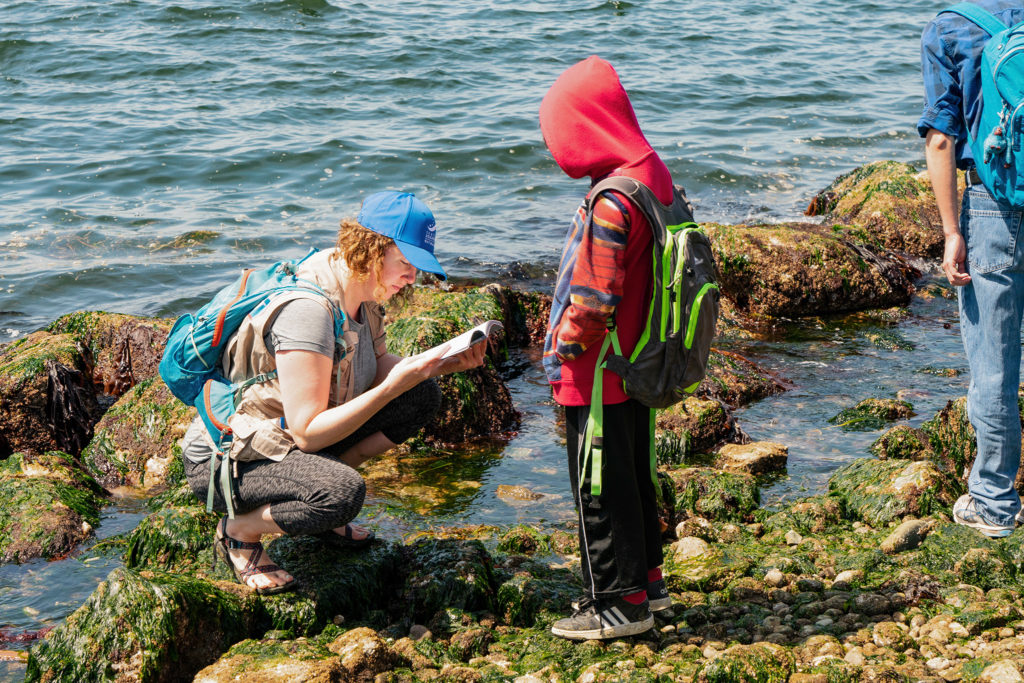The High Impact of Low Tide Beach Walks
For many, low tide is a unique opportunity to briefly view exposed seaweed, crabs and mystery objects before watching them become engulfed by the ocean.
However, for members of the Beach Naturalist Program run by the Seattle Aquarium, low tide is the perfect opportunity to educate the community and encourage an appreciation for the many wondrous creatures usually hidden below the ocean’s surface.
The Seattle Aquarium relaunched this event in 2012 as a way to engage intimately with members of the community and with efforts to educate and spread enthusiasm for the Puget Sound environment.

Katie Osterhage describes a sea creature to a little boy on the Low Tide Walk with the Seattle Aquarium.
Community Engagement Liaison and naturalist Kayla Grattan encourages attendance, reminding the community that the event will continue all summer at nine different Seattle beaches at varying times.
“You can come to a new beach and experience a totally new system than the one you’re used to every time,” Grattan said.
Grattan has spent two seasons with the naturalist program, getting involved after moving to Seattle with an environmental studies degree.
“I was familiar with tide pooling; I’d done it for work elsewhere. I found out about the naturalist program and here we are,” Grattan said.
She noted that the job quickly became a ‘jobby,’ a mix between a job and a hobby.
“I really like bridging the gap between education and us people who live so close to places like this but may not get the opportunity to learn about them,” Grattan said.
Low tide naturalist Christine Veterhart shares a similar enthusiasm for the program, seizing the opportunity to join after being approached by other naturalists.
According to the Seattle Aquarium website, “beach naturalists are local citizens who care about Puget Sound beaches and want to help protect them.”
“I just started by having fun with another naturalist,” Veterhart said. “I knew nothing about this ‘cause I don’t usually hang out in the low tides, but there’s a ton to learn every single day.”
Veterhart hopes her story will encourage others to come to a low tide walk or consider joining the program themselves.
Other attendees were quite familiar with tide pools, though they were still adamant about the importance of attending similar events.
“You think you know empathy but then you’re thinking about these little critters down here and you’ve never had compassion for them. It increases your appreciation just being here.”
Anna Bruchette was one such attendee, a biologist with a doctorate in virology and a passion for tide pooling.
“It’s an opportunity to discover the creatures that are out here and just take some time to look at the things you wouldn’t usually look at,” Bruchette said.
Bruchette also reinforces the importance of education, noting how valuable it is to have the naturalists accessible for questions.
“There are so many questions you can ask about what you explore and see and that’s a great way to learn about the world and how things are interconnected,” Bruchette said.
Along the beach, a plethora of unique creatures could be viewed upon taking a closer look at the seaweed and between rocks.
Anemones of all shapes, colors and sizes were nestled beside rocks and other debris. Clams burrowed deep under the sand and sent jets of salty water through their siphons onto unsuspecting passersby in response to disturbances.
Moon snail egg cases littered the beach, looking like rubber car parts rather than eggs. This, Veterhart explains, can be an issue as many volunteers conducting beach clean-ups misidentify the egg cases as discarded plastic.
“You think you know empathy but then you’re thinking about these little critters down here and you’ve never had compassion for them. It increases your appreciation just being here. You can see all these wonderful things going on and carry it into the rest of your life and your other interactions,” Veterhart said.
With the rising tide, the walk was concluded for the day. However, the opportunity for education and appreciation of the tide pools continues through August 4.
Though the program is geared towards conservation, the naturalists remind us of the importance that such an event can have in the simplest ways.
“Anytime you get outdoors it’s a very healing thing,” Veterhart said. “Come on out and have some fun, it’s amazing what you’re able to see.”
Grattan adds to this idea, mentioning that whether you are able to attend the events or not, we should all strive to understand the importance of conservation, especially in areas so close to home.
“Keep up the good work, spread our conservation method through your work–we really appreciate it.”
Kristen may be reached at
knielsen@su-spectator.com


orlay
Feb 14, 2022 at 10:26 am
Great story and fun read. Worthwhile program, hope it goes on well into the future.